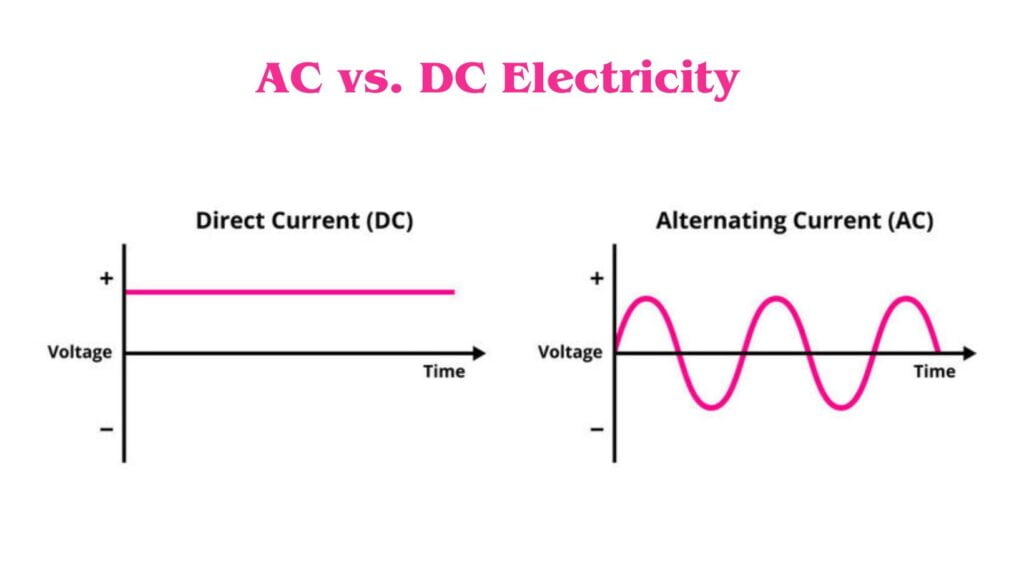Types of Electricity: AC vs. DC
Electricity comes in various types, and one common way to categorize it is based on the flow of electric charge. The two primary types of electricity are Alternating Current (AC) and Direct Current (DC). Let’s explore the characteristics and applications of each:

1. Alternating Current (AC):
- Characteristics:
- In AC, the electric charge flows in a constantly changing direction, regularly reversing its path.
- It is characterized by a sinusoidal waveform, where voltage and current values oscillate back and forth.
- AC voltage in most homes and businesses typically oscillates at a frequency of 50 or 60 Hertz (Hz), depending on the region.
- Applications:
- AC electricity is the standard for most power transmission and distribution systems. It is highly efficient for long-distance transmission due to its ability to change voltage levels easily.
- It is the primary type of electricity used in homes and businesses to power lighting, heating, air conditioning, and most household appliances.
- AC is suitable for electric motors in machinery, from small household appliances to large industrial equipment.
2. Direct Current (DC):
- Characteristics:
- In DC, the electric charge flows consistently in one direction, maintaining a constant polarity.
- It is represented by a steady, unidirectional flow of electrons.
- Applications:
- DC is commonly used in batteries, as it provides a stable and continuous source of electrical energy.
- Many electronic devices, such as smartphones, laptops, and portable music players, operate on DC power, often derived from batteries or adapters that convert AC to DC.
- DC is essential in certain electronic components like diodes, transistors, and integrated circuits, which rely on a constant polarity for their operation.
- DC is also prevalent in specialized applications like electric vehicles, solar panels, and certain types of motors.
In summary, AC and DC electricity differ in the way the electric charge flows. AC alternates its direction, while DC maintains a constant flow in one direction. The choice of electricity type depends on the specific application and the advantages each type offers. Understanding these differences is essential in various fields, from electrical engineering to everyday use, as it influences how we design, operate, and interact with electrical and electronic systems.
AC: The Ebb and Flow of Energy
AC, Alternating Current, is like a rhythmic dance of electrons that constantly changes direction. In an AC system, the electric current oscillates back and forth, achieving a sinusoidal wave pattern. These changes in direction occur at a specific frequency, typically 50 or 60 times per second (measured in Hertz, Hz).
Applications of AC Electricity:
- Household Power: AC is the dominant power source in homes. It’s safe for distribution and can easily be transformed to different voltage levels.
- Commercial and Industrial Power: AC’s adaptability makes it ideal for powering factories and large machinery.
- Transmission: AC is the choice for long-distance power transmission, reducing energy loss.
- Alternators and Generators: AC generators are efficient at converting mechanical energy into electrical power.
- Motors: AC motors are common in household appliances, pumps, and industrial machinery.
DC: The Steady Flow of Electrons
DC, Direct Current, is like a consistent river of electrons flowing in a single direction. The current doesn’t change direction, maintaining a steady flow.
Applications of DC Electricity:
- Batteries: Portable electronic devices like smartphones, laptops, and electric vehicles rely on DC power from batteries.
- Electronics: Integrated circuits, microcontrollers, and digital devices often use low-voltage DC power.
- Automotive Industry: DC powers the vehicle’s electrical system and is essential for starting the engine.
- Solar Panels: Photovoltaic systems generate DC electricity, which is converted to AC for grid connection.
- Railways: Trains and subways use DC for propulsion.
Key Differences Between AC and DC:
- Direction of Current: AC changes direction, while DC flows in a constant direction.
- Voltage Levels: AC voltage levels are easily adjustable, while DC voltages are generally fixed.
- Generation: AC is primarily generated by alternators, while DC is produced by batteries and rectifiers.
- Distribution: AC is used for long-distance power distribution due to lower energy loss, while DC is mainly used for shorter distances.
- Safety: AC is safer for long-distance transmission, but DC is preferred for low-voltage, portable devices.
FAQs
1. What is the primary difference between AC and DC electricity?
AC, or Alternating Current, flows back and forth, changing direction periodically, while DC, or Direct Current, maintains a steady flow in one direction.
2. Why is AC the preferred choice for household power distribution?
AC is chosen for homes due to its ease of transformation to different voltage levels, efficient long-distance transmission, and safety advantages over DC.
3. Where is DC electricity commonly used in everyday life?
DC is commonly found in portable electronic devices like smartphones, laptops, as well as in automotive systems, solar panels, and railways.
4. What are the voltage characteristics of AC and DC power systems?
AC voltage levels are adjustable, whereas DC voltages are typically fixed.
5. What is the significance of the frequency in AC electricity?
Frequency, measured in Hertz (Hz), determines how often AC current changes direction per second. It affects the performance of electrical devices and grid synchronization.
6. Can AC and DC systems coexist in the same electrical network?
Yes, they can coexist in the same network through the use of converters and inverters, allowing for efficient power transmission and compatibility with various devices.
Conclusion
Understanding the differences between AC and DC electricity is vital as we navigate a technology-driven world. AC’s versatility and efficient long-distance transmission make it ideal for powering our homes and industries. Meanwhile, DC’s stability and adaptability shine in the world of electronics, portable devices, and sustainable energy solutions. Together, these electrical systems harmonize to bring power and convenience to our lives, underpinning the evolution of technology and the modern world as we know it.
 Electrical Engineering World Wiring a Brighter Tomorrow!
Electrical Engineering World Wiring a Brighter Tomorrow!